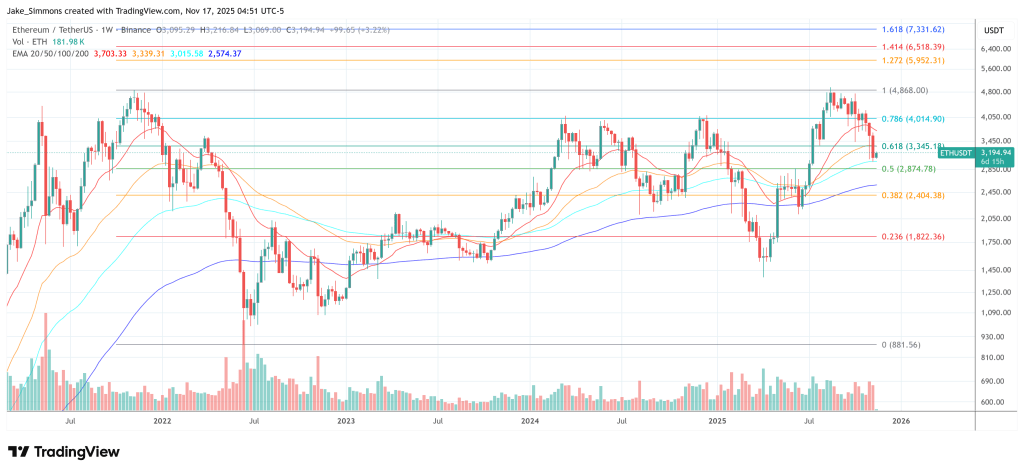
At the Ethereum Cipherpunk Congress 2 on November 16, 2025, Vitalik Buterin used his keynote “Kohaku: Wallet Privacy in Ethereum” to deliver a scathing verdict on the state of Ethereum’s privacy. The encryption works, but the user experience is failing.
He began by reminding the audience that Ethereum has been investing in privacy and security infrastructure for 10 years. He cited the elliptic curve precompilation “EC-add, EC-mul, and EC-pairing” added in 2018 as the basis for protocols such as Tornado Cash and Railgun, and noted the work of the Privacy & Scaling Explorations team on the zkSNARK protocol, developer tools, and application layer experimentation.
On the security front, he called the 2016 DAO hack a “huge galvanizing event for the ecosystem,” leading to increased auditing, teams like SEAL, more secure Solidity and Vyper, and multisig wallets that were “almost a dream in 2015” but are “very mainstream today.”
Vitalik propels Ethereum towards true wallet privacy
Despite these advances, Buterin argued that everyday users still struggle to access meaningful privacy and security. “We’re not quite there yet in terms of real-world privacy and security provided to users,” he said. “And that’s what could change, and that’s what could change this year.”
Technically, the core privacy stack is mature, he argued. “The base layer technology is all great. You can generate a proof in less than a second on a laptop and less than two seconds on a mobile phone. It’s easy to develop. It’s very well understood. There are a lot of well-tested circuits.” The breakdown happens at the wallet layer.
“Using the privacy protocol requires a separate seed phrase. There is no multisig option. Therefore, if you are storing your coins in a private pool, your coins must be controlled by a single key,” he explained. Users typically need to open a separate privacy wallet, and “private transfers and withdrawals require about five clicks.” Even the infrastructure for broadcast trading is vulnerable. “Last week I had to battle with public broadcasting. It took about 10 tries before I finally figured out that turning on the VPN worked.”
“We are in the very last mile,” he concluded. “We are really at the last mile stage and we need to put in a lot of effort to do better.”
Buterin framed Amber within the broader privacy protections he laid out in his April essay. On stage he summed it up in three lines. “Privacy is freedom…privacy is order…and privacy is progress.” He said privacy “gives us the space to live our lives in a way that meets our needs,” underpins a fundamental social mechanism that assumes that no one sees everything, and is essential for the use of data in fields such as medicine and science without creating “dystopian nightmares.” With modern encryption, “we can design to put privacy first.” For users, “privacy is not an abstraction. It’s a tangible benefit for users, and we can now show that we have it.”
In his view, security is similarly dominated by tail risks. Referring to the meme, he contrasted DeFi yields with catastrophic losses. When you put your assets into DeFi, you “earn an APY.” If you do nothing, your APY will be 0%. However, if you lose your private key, your APY will be “minus 100.” The same goes for “if Lazarus discovers your private key” or “if the wrong people find out how much you have, who you donate to, or where you live.”
Buterin argued that the Ethereum privacy debate has focused too narrowly on “what can be ZK-proofed on-chain.” He expanded the scope to include UX (making it easier to separate wallet identities), read privacy (via better RPC, E3T, E+ORAM, or PIR, which is a “really pure cryptography approach”), network-level privacy through Mixnet, and non-financial operations that also need protection.
Regarding security, he called for “risk-based access control,” saying, “If you want to move $100,000, you need to press more buttons and get more permissions than if you want to move $10.” He emphasized account recovery, UI-level security, and “on-chain versioning” of software dependencies and UIs, arguing that “we should enable a world where the UI lives on-chain” so that attackers can’t hack servers and silently replace the front end.
Today @web3Privacymaestro @VitalikButerin highlighted #ambera new Ethereum framework focused on bringing true privacy to wallets. $eth
Click here for the full 8 minutes: pic.twitter.com/W9qeUZcipR
— Tommy B. 🇺🇸 (@realtommybibi) November 16, 2025
Summing up Ethereum in 2025, Buterin said Ethereum has “strong security and privacy research,” “strong L1 security,” privacy tools, and is “miles of improvement” from “the first version of Zcash,” where “it took two minutes to sign a transaction.” What remains, he argued, is “leveling up the last mile,” especially “the application layer and the wallet layer, which are the parts of this whole problem that are closest to the user.”
Kohaku was announced on October 9th by the Ethereum Foundation via X. “The Ethereum Foundation is proud to build Kohaku, a set of primitives that makes wallets secure and allows you to process private transactions while minimizing dependence on trusted third parties. Privacy is normal. Privacy belongs to everyone.”
At the time of writing, ETH was trading at $3,194.

Featured image created with DALL.E, chart on TradingView.com

editing process for is focused on providing thoroughly researched, accurate, and unbiased content. We adhere to strict sourcing standards, and each page is carefully reviewed by our team of top technology experts and experienced editors. This process ensures the integrity, relevance, and value of your content to your readers.


